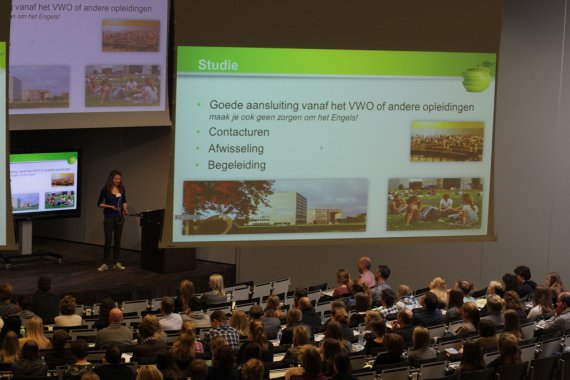Photo: Niels van Mosselvelde
Carlijn Wentink, lecturer in Public Health and Society, is happy that the evening classes have been abolished, although she still thinks that lectures until 19:00 are ‘undesirable’. She admits, however, that every new system has its kinks. ‘If we want to find a solution to the scheduling issues, we will have to be pragmatic and search for solutions together. I do not think the option currently proposed is such a bad one.’
Hydrogeology lecturer and Teacher of the Year 2016 Roel Dijksma thinks the proposal is ‘an interesting idea, but it still has snags. It is a good idea to explore the possibilities to accommodate larger numbers of students. Evening classes, dusk classes, additional buildings – each option has its pros and cons.’
Short break
The lecturers are mostly concerned about shortening the breaks during lectures: they are cut down from fifteen to ten minutes. Dijksma; ‘I currently have a crowd of about eighty students in front of me. Grabbing a cup of coffee is already tight, but relaxing a bit and letting some blood flow to the buttocks is barely possible anymore. I feel sorry for them, sitting on those wooden seats.’
‘For me, the major problem with the shorter breaks is that it is often the opportunity for students to ask me questions’, says Wentink. ‘These informal moments of contact are very important.’ For associate professor and Teacher of the Year 2017 nominee Henry van den Brand, the breaks are important for interaction with students. ‘I use the breaks to reflect with the students on whether the course material has hit home. I get great feedback during breaks, and I am available for the students to discuss various matters.’
Lunch meetings
Besides that, Wentink and Van den Brand also see an agenda-related challenge raised by shorter lunch breaks, for both lecturers and students. Wentink: ‘We currently use the lunch breaks for meetings that have to be attended by many different lecturers, as no one is teaching at those times. If the lunch breaks would be shortened to 30 minutes, those meetings would not be possible anymore.’ Van den Brand: ‘There are regularly interesting lunch meetings for students, in Impulse, for example. Those should remain a possibility. The break around noon is also very useful and important for various committees and boards. In view of that, I find shortening it somewhat questionable.’
The idea of cutting down the lectures from 45 to 40 minutes is less of a concern to the lecturers. ‘My lectures aren’t metered chunks of 45 minutes’, says Dijksma. ‘I have several pauses during a lecture that I can activate at a glance at the time. I could do the same with slices of 40 minutes.’ According to Wentink, lectures that last two blocks of 45 minutes are ‘merely an agreement’.
However, they do hope the university will offer the possibility to catch up on material that has not been treated at a later time. Dijksma: ‘Giving up on all these little blocks of five minutes means you will have to discard part of the material. That means you will have to discard content, and that cannot be the point of this approach.’ Wentink: ‘Perhaps it will be possible to plan an additional two or three lectures over the entire course, to be able to treat the entire material after all.’

